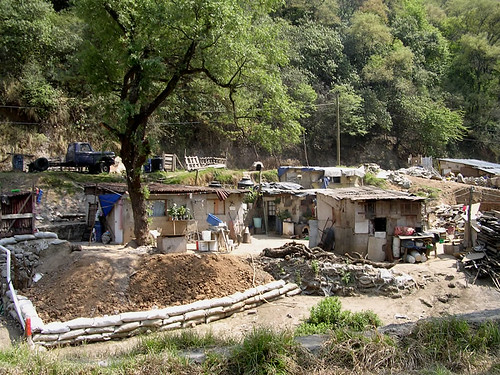
Mexico City

Facts
Mexico City is the capital and largest city in Mexico with a population of over 8.84 millionIt is located in the Valley of Mexico, a large valley near the center of Mexico, at an altituded of 7300 feet. Mexico City served as the political, administrative and financial centre of a major part of the Spanish colonial empireIt gained independence from Spain in 1824 and the Federal District was createdToday, it is one of the major political, economic, cultural and financial centers of the country and a global city in Latin AmericaMexico City's metropolitan area population is 21.2 million people; it is the largest metropolitan area in the Americas and third largest agglomeration in the world (behind New York and Tokyo)Mexico City consists of 16 boroughs for administrative purposes, the largest of which is Iztapalapa with a population of 1,856,515.In 2005, Mexico City was the 25th largest economy in the world with a Gross Domestic Product of $390 billion (in US dollars)It is the eighth richest city in the world (by overall GDP in the metropolitan area) and is expected to be 7th by 2025.Some of the largest problems that the city faces are pollution, dwindling water supply, and poor air qualityIndustrial growth and urbanizaton have contributed to this situation in Mexico City

Employment
Mexico City produces 21.8% of the country's gross domestic product, and is the richest city in Latin America. About 1,000 citizens of poor rural areas in Mexico migrate to Mexico City in search of job opportunities daily.Of the total labor force in Mexico City, 98.35% is employed, whereas only 2.44% is unemployed.Suprisingly, young people who have a university education are the group most affected by unemployment. Although Mexico City has the smallest unemployment rate in the world, many of its employees receive low wages and do not work the complete labor day. This explains why the Mexico City labor force has a low productivity.As a whole, Mexico's unemployment rate is very low compared to neighboring countries. This does not mean, however, that the country does not have problems. 400,000 jobs have been lost in a periodof about six years.Though in 2005 there was a demand for about 1.2 million jobs, only about 300,000 new jobs were created. This created at defecit of about 900,00 jobs for that year alone.
aCause/Effect
One cause of the rural to urban migration in Mexico City, and many other similiar cities, is the availability of low skill jobs. These types of jobs, which are normally known for low productivity and self employmen.t make up a third of all urban income. "Push" and "pull" factors cause rural to ubran migration. Push factors, in this case, can be defined as factors that discourage people from remaining in a rural area. An example of a push factor would be a drought which causes a rural farmers crops to die. A pull factor, or factor that would increase the appeal of the urban area, would be the prospect of job opportunities in the city. The combination of these two employment-related factors have contributed largely to patterns in rural to urban migration.Traditonially economic opportunity has been associated with cities and seems to outweigh any negative aspects such as a high crime rate and congestion. People feel the need to support themselves and their families by having a job and steady income and believe they will find this in an urban area.
aAdditional Sources Used
http://docs.google.com/viewer?a=v&q=cache:2SCA3ccoOJ4J:emi.pdc.org/cities/CP-Mexico-July2006.pdf+unemployment+mexico+city&hl=en&gl=us&pid=bl&srcid=ADGEESgO_lnl3uRJ8_7awnqpS8ndYvCAOpxo14f29BrSOigWeMKKWAYLoyOaEQg99zMZIiXVfRUbNFTJ0AnHrcffHQfAyVW9g_32zhX42h-NdFvs-6ciieHfhFjmZbNLg8-7RL38kVVD&sig=AHIEtbQi8lN6XsPzJKZ26LfL4oxTkB_ocAesa.un.org/unup/p2k0data.asphttp://www.foreignpolicy.com/story/cms.php?story_id=4509&page=1http://www.ehow.com/facts_4884476_facts-mexico-city.htmlhttp://wps.aw.com/aw_todarosmit_econdevelp_8/0,6111,284700-,00.htmlhttp://www.globalchange.umich.edu/globalchange2/current/lectures/urban_gc/http://www.springerlink.com/content/w7154865665wgx47/

Rural to Urban Migration
Mexico City started to see an influx of people migrating from rural areas between 1920 and 1921, during the time of the Revolution.Approximately 108,000 people came to Mexico City from different provinces in order to escape the violenceA second wave of migrants came in the 1950's and 1960's. This was mainly due to the fact that this is where most industries were started and most jobs were created.In the 1960's about 50 percent of the Mexican population lived in rural areas. That number has now fallen to just 20 percent due to a continuous trend of rural-to-urban migration.Now approximately 1/3 of Mexico City's residents are migrants. Many of these people are hopeful about what the city offers--jobs, schools, cheap food, affordable transportation, and modern health care.Mexico City continues to be the largest metropolitan city in Mexico and is a major center for politics, financial matters, and culture. This, along with causing many people to choose to migrate there.Every 15 years Mexico City doubles in population size.Urbanization of the city has directly effected the environment in a negative way, with the indstrial growth and population boom, pollution has increased, air quality has gone down, and water supply has lessened.In 1992, the UN described Mexico City as the most polluted city in the world.
Central City Population from 1940
Central City Population from 1940
a